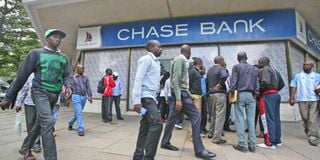Central bank lifeline facility for banks shows weakness

Chase Bank customers mill around the closed bank along Mama Ngina Street in Nairobi on April 7,2016 after the bank was placed under receivership.
What you need to know:
- President Uhuru Kenyatta was in France at the time when Chase Bank crumbled.
- CBK annual report shows that some banks increasingly came under liquidity pressure even though the average industry remains fairly liquid.
In his first year in office Central Bank Governor, Dr Patrick Njoroge, shut three banks sending a chilling message to the sector that there would be no cutting deals if one did not play by the book.
President Uhuru Kenyatta was in France at the time when Chase Bank crumbled. French Government through Agence Francaise de Development had interests in the lender having provided funds for SME lending. In fact they had given Chase Bank 10 million euros in November just six months before the financier went belly up.
As French journalists made inquiries about the bank, President Kenyatta threw his weight behind his newly appointed regulator chief, but it was clear that a different strategy would be needed and he indicated the government would want more say.
“I personally believe the governor is doing what is in the best interest of the overall banking sector and what is important to me is to ensure all our depositors especially the small depositors remain and stay protected and that is the instructions I have given my CS Treasury to ensure that all depositors are protected,” he said.
Since then no bank in Kenya has collapsed but the regulator has grown its balance sheet by the billions each year supporting struggling lenders.
Liquidity pressures
CBK’s emergency fund for struggling banks jumped fourfold to Sh37.1 billion in the year ending June 2019 from Sh7.7 billion in 2018 indicating the industry weakness even before the coronavirus pandemic.
The fund was set up four years ago after collapse of Dubai Bank, Imperial Bank and Chase Bank, to support any commercial or microfinance bank that comes under liquidity pressures arising from no fault of its own.
CBK’s latest results show that the emergency fund was the biggest component of its loans to banks which increased to Sh66.9 billion for the year ended June 2019 from Sh38.5 billion.
CBK annual report shows that some banks increasingly came under liquidity pressure even though the average industry remains fairly liquid.
Treasury bills
Banks cashed more Treasury bills before maturity even though the short term instruments need only three months and one year to become payable. The data shows that discounted Treasury bills jumped from Sh28 million in June 2018 to Sh2.5 billion by June last year, while discounted Treasury bonds reduced from 9.4 billion to Sh8.4 billion.
CBK Injected Sh20.1 billion by purchasing Repos, treasuries cashed at CBK with a promise to buy them back in future, up from Sh19.4 billion in 2018.
This shows that Banks went into the coronavirus storm with liquidity challenge that prompted the regulator to proactively increase instruments that allowed them to access cash and survive.
To ensure banks remain above the water, CBK lowered the Central Bank Rate by 125 basis point to 7 to reduce the cost of funding for banks so that they would pay less on deposits.
Banks will now only be required to keep 4.25 per cent of their deposits at CBK down from 5.25 per cent releasing Sh35 billion in cash to keep them liquid.





